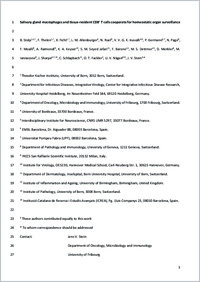Salivary gland macrophages and tissue-resident CD8+ T cells cooperate for homeostatic organ surveillance
- Stolp, Bettina Theodor Kocher Institute, University of Bern, 3012 Bern, Switzerland. - Department for Infectious Diseases, Integrative Virology, Center for Integrative Infectious Disease Research, University Hospital Heidelberg, Im Neuenheimer Feld 344, 69120 Heidelberg, Germany.
- Thelen, Flavian Theodor Kocher Institute, University of Bern, 3012 Bern, Switzerland.
- Ficht, Xenia Theodor Kocher Institute, University of Bern, 3012 Bern, Switzerland.
- Altenburger, Lukas M. Department of Oncology, Microbiology and Immunology, University of Fribourg, 1700 Fribourg, Switzerland.
- Ruef, Nora Department of Oncology, Microbiology and Immunology, University of Fribourg, 1700 Fribourg, Switzerland.
- Inavalli, V. V. G. Krishna University of Bordeaux, 33700 Bordeaux, France. - Interdisciplinary Institute for Neuroscience, CNRS UMR 5297, 33077 Bordeaux, France.
- Germann, Philipp EMBL Barcelona, Dr. Aiguader 88, 08003 Barcelona, Spain. - Universitat Pompeu Fabra (UPF), 08002 Barcelona, Spain.
- Page, Nicolas Department of Pathology and Immunology, Division of Clinical Pathology, University and University Hospitals of Geneva, 1211 Geneva, Switzerland.
- Moalli, Federica IRCCS San Raffaele Scientific Institute, 20132 Milan, Italy.
- Raimondi, Andrea IRCCS San Raffaele Scientific Institute, 20132 Milan, Italy.
- Keyser, Kirsten A. Institute for Virology, OE5230, Hannover Medical School, Carl-Neuberg-Str. 1, 30625 Hannover, Germany.
- Jafari, S. Morteza Seyed Department of Dermatology, Inselspital, Bern University Hospital, University of Bern, Bern, Switzerland.
- Barone, Francesca Institute of Inflammation and Ageing, University of Birmingham, Birmingham, UK.
- Dettmer, Matthias S. Institute of Pathology, University of Bern, 3008 Bern, Switzerland.
- Merkler, Doron Department of Pathology and Immunology, Division of Clinical Pathology, University and University Hospitals of Geneva, 1211 Geneva, Switzerland.
- Iannacone, Matteo IRCCS San Raffaele Scientific Institute, 20132 Milan, Italy.
- Sharpe, James EMBL Barcelona, Dr. Aiguader 88, 08003 Barcelona, Spain. - Universitat Pompeu Fabra (UPF), 08002 Barcelona, Spain. - Institució Catalana de Recerca i Estudis Avançats (ICREA), Pg. Lluis Companys 23, 08010 Barcelona, Spain.
- Schlapbach, Christoph Department of Dermatology, Inselspital, Bern University Hospital, University of Bern, Bern, Switzerland.
- Fackler, Oliver T. Department for Infectious Diseases, Integrative Virology, Center for Integrative Infectious Disease Research, University Hospital Heidelberg, Im Neuenheimer Feld 344, 69120 Heidelberg, Germany.
- Nägerl, U. Valentin University of Bordeaux, 33700 Bordeaux, France. - Interdisciplinary Institute for Neuroscience, CNRS UMR 5297, 33077 Bordeaux, France.
- Stein, Jens V. Department of Oncology, Microbiology and Immunology, University of Fribourg, 1700 Fribourg, Switzerland.
-
03.04.2020
Published in:
- Science Immunology. - 2020, vol. 5, no. 46, p. eaaz4371
English
It is well established that tissue macrophages and tissue-resident memory CD8+ T cells (TRM) play important roles for pathogen sensing and rapid protection of barrier tissues. In contrast, the mechanisms by which these two cell types cooperate for homeostatic organ surveillance after clearance of infections is poorly understood. Here, we used intravital imaging to show that TRM dynamically followed tissue macrophage topology in noninflamed murine submandibular salivary glands (SMGs). Depletion of tissue macrophages interfered with SMG TRM motility and caused a reduction of interepithelial T cell crossing. In the absence of macrophages, SMG TRM failed to cluster in response to local inflammatory chemokines. A detailed analysis of the SMG microarchitecture uncovered discontinuous attachment of tissue macrophages to neighboring epithelial cells, with occasional macrophage protrusions bridging adjacent acini and ducts. When dissecting the molecular mechanisms that drive homeostatic SMG TRM motility, we found that these cells exhibit a wide range of migration modes: In addition to chemokine- and adhesion receptor–driven motility, resting SMG TRM displayed a remarkable capacity for autonomous motility in the absence of chemoattractants and adhesive ligands. Autonomous SMG TRM motility was mediated by friction and insertion of protrusions into gaps offered by the surrounding microenvironment. In sum, SMG TRM display a unique continuum of migration modes, which are supported in vivo by tissue macrophages to allow homeostatic patrolling of the complex SMG architecture.
- Faculty
- Faculté des sciences et de médecine
- Department
- Département de Médecine
- Language
-
- English
- Classification
- Biological sciences
- License
-
License undefined
- Identifiers
-
- RERO DOC 328393
- DOI 10.1126/sciimmunol.aaz4371
- Persistent URL
- https://folia.unifr.ch/unifr/documents/308636
Statistics
Document views: 214
File downloads:
- pdf: 555
